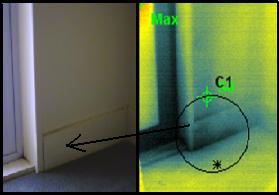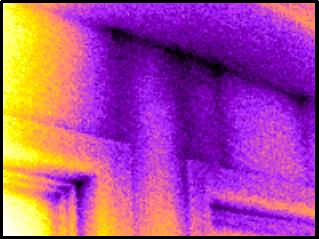“Can you moisture test a home on dry summer days? “… a common question clients ask in summer time.
Yes you can, but there’s a couple of things to consider. Before I explain further, here’s a photo of a major leak below a window that we detected on a hot dry Auckland day with thermal imaging and moisture meters… (You can see the mould stain on the internal side of fiber cement board)
This is a very common type of window leak that was caused be cracks opening up around where the plaster cladding meets the aluminium window frame. There were no visual signs of this leak on gib board, skirting or external cladding.
So can you detect moisture problems in houses when it hasn’t rained?
First of all, there is a difference between moisture and leaks. Moisture will accumulate in a wall (with no cavity), and penetrate into insulation as a result of a leak. Moisture will stay long term, even if you fix the source of the leak… and if the timber in the area is untreated, mould and decay will start to take place, and you won’t even know it. A pitched roof leak for example could be missed if it hasn’t rained for some time, as the air circulation in the ceiling space will potentially dry the leak out… but not so with trapped moisture in walls.
The moisture damage below the window above was due to lack of cladding maintenance around the windows… coupled with design issues.
Here’s part 2 of what happened with the job above:
The home owner got his local builder to take the gib board off where we had found the leak. The vendor then had the source of the problem fixed and they used a dehumidifier to dry the area out. He kept the area open and dry of two weeks before replacing the gib, plastering and painting. The reason he went ahead and closed it all back up is because the timber frame looked and felt dry… and the screwdriver didn’t go through the timber when he tested further. Then…
He called me back to do a ‘re-test’ and get a clean moisture report. Guess what? After all that time drying it out, the moisture readings came back at 60% (Well over 18 – 20% moisture that it should be). Why was this? The moisture was inside the untreated timber and couldn’t be ‘seen’. See, the window leak was running down the internal side of the cladding where the timber frame was touching, therefore the majority of the water was soaking in through the back on the timber and across… and didn’t leave much visual evidence on the side of the timber that could be viewed.
Now what?
The area is now getting pulled back apart and the timber is coming out. Ideally, he would have had it moisture tested before closing it back up.
Summary: Dehumidifiers won’t completely dry out moist untreated timber, and what ‘looks’ dry may not be… even if you can’t push a screwdriver through it.
Further info about how moisture can accumulate in walls HERE








